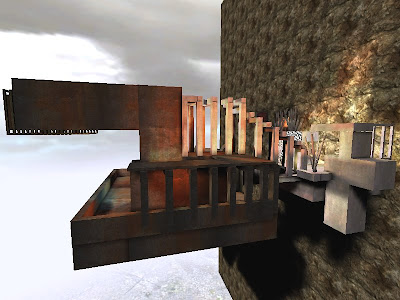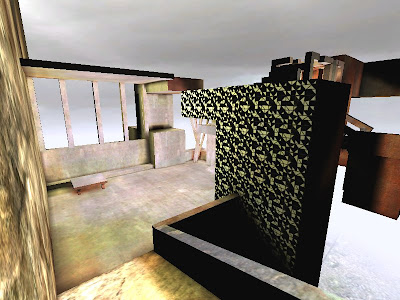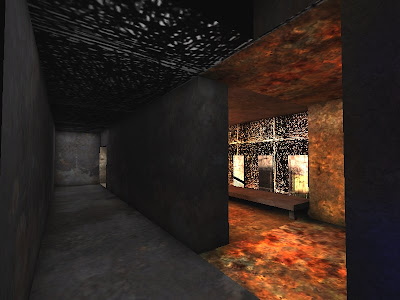Sunday, June 21, 2009
EXP3 - FINAL SUBMISSION DOWNLOAD
Note: All of my elevators work, however sometimes they need to be nudged or jumped on a few times. I seem to always getting the elevator working the second time i bump it rather than the first.
Monday, May 25, 2009
Monday, May 18, 2009
Thursday, May 14, 2009
Fixed Exp2 Download Link
http://files.filefront.com/DM+ARCH1101+Linh+Nguyen1ut2/;13754847;/fileinfo.html
Sunday, May 10, 2009
EXP 3 - Article Mash up
Miuccia Prada has a certain serenity. As she took office, voters seemed optimistic for her to reach the most rarefield and potent ranks of fashion. Her power makes her a star, which was manifested with political advantage in the black nylon backpack draped over every influential arm. What sets her apart is her plans to offer herself and every aspect of her career. 'She never follows anyone else's lead, just her own original energy.' But one thing Prada is unafraid of, is a good political fight. And more often then not, she wins.
Madonna has this thing about her that you can't explain - the thing to make something permanent and optimistic. Madonna was the first star to take control of every aspect of enemies, fashion, dealmaking, designing, the internet and every aspect of her career. Madonna's stage presence has inspired and given hope to so many artisits. Madonna has so much life and juice inside her and she stuck to what she believed in and constantly did what she felt, and that was part of her art and energy - to just be herself.
Madonna Article
The Immortals - The Greatest Artists of All Time: 36) Madonna
I'm sorry, but I'd rather meet Madonna than the president of the United States. Madonna has this thing about her that you can't explain -- the thing that makes somebody a star. When she walks into the room, you just have to take notice. She's so comfortable with herself, and she's not afraid to live life to the fullest and to say whatever she feels, no matter what anyone thinks. There's something kind of childlike about that; it's a beautiful, amazing thing.Madonna was the first female pop star to take control of every aspect of her career and to take responsibility for creating her image, no matter how much flak she might get. She's proved that she can do so many different things -- music and movies and being a parent, too. Her music has become iconic: Songs like "Holiday" or "Live to Tell" are timeless -- not just disposable hits. They feel like home. She has her spells of being moody and vibey and spiritual, but her words are so easy to relate to. She's a diva and does what she wants, but she's a loving person.
The first time I met her was when I flew to visit her at one of her shows in 2001. I walked into her dressing room, and her daughter, Lola, was there, and I felt really nervous. I said to Madonna, "Can I just hug you?" I was so stupid! But she was so nice about it. I would definitely not be here, doing what I'm doing, if it wasn't for Madonna. I remember being eight or nine years old, running around my living room singing and dancing and wanting so much to be like her. All my girlfriends still listen to her stuff. We're all mesmerized by her. Madonna's stage presence has inspired so many artists -- you can see her influence in some of the younger generation like Kelly Clarkson and Shakira, who have picked up some of her moves.
As part of the generation that's coming up, you look at Madonna and you don't want to let her down. That's such a motivation for me. I love doing what I do, but when Madonna comes around -- like when we were making the video for "Me Against the Music" -- it's like, "Everybody get your act together -- the godmother is here."
Madonna has done so much, and she's been around so long, and the bitch still looks good! She's spent years in the public eye, and that can be really hard for anyone to deal with. But she dug deep and started writing from her heart, and that's therapy to keep you going. Madonna has so much light inside her, and she's so much more noticeable than all of the rest of us. She stuck to what she believed in and did what she felt, and that was part of her art -- to just be herself.
Source: Britney Spears, The Immortals - The greatest artists of all time 36) Madonna, The Rolling Stones Magazine, Issue 946 April 15, 2004 [http://www.rollingstone.com/news/story/5940017/the_immortals__the_greatest_artists_of_all_time_36_madonna] Accessed 09 May 2009
Muiccia Prada Article
W O M E N I N F A S H I O N
2. Miuccia Prada
Fashion's Auteur, True To Her Own Eye
Desperation and luxury are mortal enemies. Fear and power do not peacefully coexist. It follows, then, that she who wishes to reach the most rarefied and potent ranks of fashion, whether in dealmaking or designing, must have a certain serenity. A certain above-the-fray quality. And a flat-out disregard for what you think. Which brings us to Miuccia Prada. The rise of Mrs. Prada, as she is known to her Italian staff members, is a well-known tale—your basic story of a onetime communist and mime student from Milan who takes over her family's dusty luggage company and, with the help of her go-getting husband, turns it into a luxury conglomerate that in 2002 had revenues of about $1.9 billion. Her power, first manifested in the minimal black nylon backpack draped over every influential arm in the '90s, also became incarnate in such celebrities as Uma Thurman, twirling down the red carpet in ethereal Prada-designed Oscar gowns.
But having created some definitive design benchmarks, while a sure sign of her eye, is not what has really given Prada her juice. What sets her apart is her disregard—in some cases, her open contempt—for the dictates of fashion. Whereas fashion expects an image to be constantly updated, Prada reportedly sank upwards of $100 million into projects that are supposed to be permanent, if not immutable: her architecturally pioneering stores in New York City (by Dutch brainiac Rem Koolhaas) and Tokyo (by the precise Swiss duo Herzog & De Meuron). Whereas common sense says a designer should design what she likes, Prada will choose a color (such as turquoise) that she despises, because of the rush it gives her when she can make something beautiful with it.
Prada has few celebrity friends. She lives in the apartment she grew up in. And, of course, season after season, she sends intelligent, beautiful and, inasmuch as anything in fashion can be, sui generis collections down the Milan runways. "If you want to know what a season is about, you don't miss the Prada show," says Julie Gilhart, fashion director for Barneys. "She never follows anyone else's lead, just her own original energy. Her collections are completely an expression of herself."
And herself is curious, independent and thoughtful. Prada once showed a raincoat that was transparent until it got wet and became opaque. This season she charmed the front row with a collection inspired by 1950s souvenir scarves and the quirky tchotchkes (beaded bags, raffish straw hats and embroidered suede moccasins) that a stylish housewife might have picked up on a honeymoon in Venice. Prada the company has not been immune to the economic downturn and has some challenges ahead, including a heavy load of debt that it has been working to pay off. But one thing Prada the woman is unafraid of is a good fight. And more often than not, she wins.
Source: Belinda Luscombe, Style & Design, Time Magazine, Monday 16 February 2004 [http://www.time.com/time/magazine/article/0,9171,993332,00.html] Accessed 09 May 2009
Barack Obama Article
Barack Obama
Barack Hussein Obama was sworn in as the 44th president of the United States on Jan. 20, 2009. The son of a black man from Kenya and a white woman from Kansas, he is the first African-American to ascend to the highest office in the land. He is also the first new president since terrorists attacked New York and Washington on Sept. 11, 2001, the first to use the Internet to decisive political advantage, the first to insist on handling a personal smartphone while in the White House. So striking was the unlikeliness of his candidacy that he embraced that aspect, calling himself "a skinny kid with a funny name" and making "change" the theme for his campaign.It was a theme with deep resonance for a country enmeshed in what was widely believed to be the worst downturn since the Great Depression. Abroad, many challenges loomed: the war in Iraq, the worsening conflict in Afghanistan, the repercussions from Israel's broad assault on Gaza, the threat of terrorism and the increasing signs that the economic woes that began on Wall Street had spread across the global economy.
Mr. Obama arrived at the White House with a resume that appeared short by presidential standards: eight years in the Illinois State Senate, four years as a senator in Washington. He had managed to wrest the Democratic nomination from a field of far more experienced competitors, most notably Senator Hillary Rodham Clinton, whom he outlasted in what became an epic primary battle. And he defeated Senator John McCain, the Republican of Arizona, by an electoral margin of 365 to 173, while outpolling him by more than eight million votes.
During the campaign, Mr. Obama laid out a set of large promises that were solidly within the traditional agenda of the Democratic Party, with plans to offer health insurance to all and reduce carbon emissions at the top of the list. At the same time, he proposed moving toward what was sometimes called a post-partisan landscape, appealing to voters of all stripes to come together. As he took office, voters seemed cautiously optimistic, with high hopes for the Obama presidency mixed with a sense that complicated problems would take years to resolve.
The Obama administration's early months in office were dominated by a single issue: the economy. In fact, the economy's seemingly relentless slide in late 2008 began reshaping the Obama team's plans long before Inauguration Day, as first the candidate and then the president-elect was pulled in to discussions over whether to bail out the financial system, and then into the raging debate over whether and how to keep General Motors and Chrysler from going under.
Mr. Obama's first major initiative was a gigantic stimulus package to pump money into an economy in something close to free fall. He introduced the outlines of a plan before taking office, and spent much of his first weeks engaged in negotiations with Congress that led to the passage of a $787 billion bill. Republicans derided the bill as unaffordable and wasteful. Not a single Republican in the House voted for the package, and only three Republican Senators did -- just enough for Mr. Obama to avert a filibuster.
On Feb. 26, Mr. Obama unveiled a 10-year budget, including $3.5 trillion for the fiscal year beginning Oct. 1, that envisioned far-reaching plans to reshape the nation's economic landscape, by promoting fundamental changes in health care, education and energy policy.
Mr. Obama faced some criticism for having so crowded an agenda when the economic woes of the country were so pressing. On the auto bailout, he chose not to appoint a "car czar,'' essentially taking on that position himself with the aid of a car industry task force. Mr. Obama took an aggressive line with G.M. and Chrysler, forcing out G.M.'s chairman, Rick Wagoner, rejecting both companies' recovery plans and setting deadlines, backed up by a bankruptcy threat, for forcing radical changes. The bank bailout plan devised by Treasury Secretary Timothy H. Geithner, on the other hand, called for creating a public-private partnership for buying up hundreds of billions in so-called "toxic assets.'' Mr. Obama and Mr. Geithner also unveiled a $75 billion plan for reducing foreclosures.
Overseas, Mr. Obama quickly reshaped policy on the wars in Iraq and Afghanistan. In Iraq, he set a date of August 2010 for a pullout of most troops. He ordered that 21,000 additional troops be sent to Afghanistan, significantly stepping up American military involvement. Pakistan became a new focus of administration attention, as the Taliban continued to seize ever-larger swaths of the country's western regions.
On his second day in office, Mr. Obama issued executive orders banning torture and closing the secret prisons run by the Central Intelligence Agency. In April, he released memos from the Bush administration Justice Department that authorized brutal treatment of so-called "high value'' terrorism suspects, a move that led to calls for an independent investigation of detainee policy -- calls that Mr. Obama rebuffed.
Source: Anon, Barak Obama, The New York Times, Monday May 07, 2009 [http://topics.nytimes.com/top/reference/timestopics/people/o/barack_obama/index.html] Accessed May 09 2009
Monday, May 4, 2009
Sunday, May 3, 2009
Final Submission Exp 2
 The above image is of my entire UT Model. Keith Campbell's laboratory can be seen on the left hand side, leading towards to the ramp and meeting space on the right hand side, which can be seen more clear in the image below.
The above image is of my entire UT Model. Keith Campbell's laboratory can be seen on the left hand side, leading towards to the ramp and meeting space on the right hand side, which can be seen more clear in the image below.
The image below is an image of the ramp from the meeting space to Alfred Nobel's lab. The ramps wind around and maneuver within the small space until each end of the ramp connects to a different lab room.

 The top image is an image of one of the lab rooms in Alfred Nobel's laboratory, and the below image is the main room for Keith Campbell's laboratory, with a lookout which looks out onto Nobel's space and also his lookout.
The top image is an image of one of the lab rooms in Alfred Nobel's laboratory, and the below image is the main room for Keith Campbell's laboratory, with a lookout which looks out onto Nobel's space and also his lookout.












































